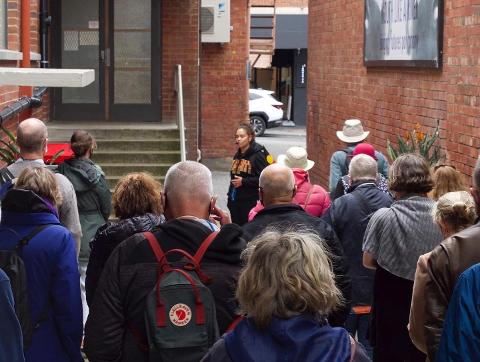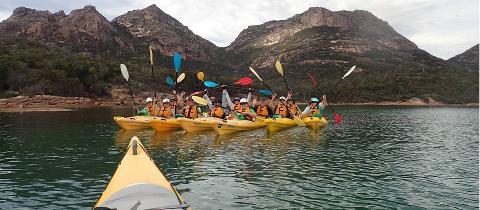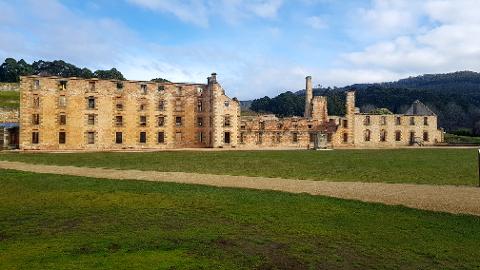 Tasmania's cultural heritage is like an open history book dating back over 35,000 years. Its legacy has been carefully preserved in its ancient Aboriginal art, language, and traditions which provide a unique window into their bygone era. Think about immersing yourself in the echoes of ancient Aboriginal chants at the Trawtha Makuminya site or learning about colonial impacts through significant events like the inauguration of the Aboriginal Information Service. Get ready to thread through historical insights of this remarkable island. Let's begin with the Aboriginals' past.
Tasmania's cultural heritage is like an open history book dating back over 35,000 years. Its legacy has been carefully preserved in its ancient Aboriginal art, language, and traditions which provide a unique window into their bygone era. Think about immersing yourself in the echoes of ancient Aboriginal chants at the Trawtha Makuminya site or learning about colonial impacts through significant events like the inauguration of the Aboriginal Information Service. Get ready to thread through historical insights of this remarkable island. Let's begin with the Aboriginals' past.
The cultural heritage of Tasmania holds immense importance, encompassing the rich history and traditions of the Tasmanian Aboriginal (Palawa) people and subsequent contributions from diverse cultural groups. This includes the preservation of ancient rock art, hand stencils, and other Aboriginal sites within the Tasmanian Wilderness World Heritage Area, highlighting the enduring importance of this heritage to all Australians.
Tasmania's Aboriginal heritage is an integral part of the island's history, dating back over 35,000 years. The indigenous people of Tasmania, known as the Palawa, have a remarkable heritage deeply intertwined with the land, marked by rich cultural traditions, art, and language. Over the millennia, they have adapted to diverse landscapes, leaving their mark through rock art sites, cave paintings, and shell middens that offer poignant insights into their way of life.
with the land, marked by rich cultural traditions, art, and language. Over the millennia, they have adapted to diverse landscapes, leaving their mark through rock art sites, cave paintings, and shell middens that offer poignant insights into their way of life.
Expanding upon this idea, the significance of sites like Trawtha Makuminya cannot be overstated. This area, purchased by the Aboriginal Land Council with conservation values and ancient Aboriginal heritage values, provides a compelling firsthand look into the interconnectedness between the environment and the indigenous people. It stands as a powerful demonstration of collaboration and stewardship between Palawa Tasmanians while serving as a living legacy of their enduring connection to the land.
Less than 1% of Tasmanian land has been returned to Aboriginal communities since 1995. The return of more land is crucial for honouring their legacy and allowing them to uphold and pass down their traditions.
Visitors to Tasmania can engage with this extraordinary heritage through guided tours that explore significant cultural sites, experience traditional dances performed by indigenous artists, and participate in immersive cultural workshops designed to provide an authentic understanding of Palawa customs and traditions. These experiences foster meaningful connections with Tasmania's rich past and create opportunities for meaningful cultural exchange.
The preservation and celebration of Tasmania’s Aboriginal heritage are not only vital elements of the island’s historical narrative but also offer invaluable insights into humanity's diverse cultural tapestry.
Tasmania's history is marked by a series of significant events that had a lasting impact on its cultural identity. Understanding this timeline helps us comprehend the complex layers that make up Tasmania's cultural heritage.
The arrival of European settlers in 1803 marked the beginning of a transformative period for Tasmania. This wasn't just about exploration; it was about colonisation — the dispossession of indigenous land and the establishment of the first European settlement, which set the stage for profound changes in the region.
The subsequent years bore witness to profound challenges, such as the Black War between 1828-1832, a period of violent conflict between British colonisers and the Tasmanian Aboriginal people. This harrowing chapter in history left deep scars on both communities and significantly shaped Tasmania's cultural landscape.
The impact on indigenous communities is an integral part of this historical narrative. The systematic elimination of the Tasmanian Aboriginal peoples is a dark chapter in Tasmania's history, impacting not only the past but also shaping the present and future of Aboriginal culture in Tasmania.
Notable milestones such as the formation of the Tasmanian Aboriginal Centre in 1979 and the official recognition of the Tasmanian Aboriginal people as the traditional owners of the land in 1995 symbolise pivotal moments in acknowledging and preserving indigenous heritage.
These key dates serve as touchstones for understanding how Tasmania's historical events have contributed to shaping its contemporary cultural fabric. They underscore the importance of recognising the enduring impact of colonisation and provide crucial context for appreciating Tasmania's cultural heritage.
By exploring this detailed timeline, it becomes increasingly evident that truly comprehending Tasmania's rich cultural tapestry requires an examination of its colonial history, and how those events continue to influence and shape social dynamics, cultural preservation efforts, and community engagement in present-day Tasmania.
As we shift our focus to the significance of natural landscapes, we embark on a journey that intertwines nature with history, revealing insights into Tasmania's unique appeal and indigenous connections to its breathtaking surroundings.
 Tasmania's stunning natural landscapes aren't just an escape from the daily hustle and bustle; they play a crucial role in preserving the history and culture of indigenous communities. The fact that about 20% of the state is under national park or reserve status is not just a testament to its ecological value, but also its cultural significance. These protected lands serve as windows into the rich heritage of Tasmania's indigenous people, showcasing their enduring connection with the land.
Tasmania's stunning natural landscapes aren't just an escape from the daily hustle and bustle; they play a crucial role in preserving the history and culture of indigenous communities. The fact that about 20% of the state is under national park or reserve status is not just a testament to its ecological value, but also its cultural significance. These protected lands serve as windows into the rich heritage of Tasmania's indigenous people, showcasing their enduring connection with the land.
The Tasmanian Wilderness World Heritage Area (TWWHA) stands out as a prime example of this special connection. This vast area is home to numerous Aboriginal sites, including hand stencils and rock art sites. These sites illuminate the ancient traditions and practises of the Palawa people, allowing visitors to gain insight into the deep-rooted cultural significance of the landscape.
The TWWHA represents a living link between past and present, offering a tangible connection to the ancestral lands of the Palawa people. Its inclusion on the World Heritage list acknowledges its outstanding universal value and its importance to all humanity, serving as a powerful reminder of the enduring legacy of Tasmania's first inhabitants.
By safeguarding these natural landscapes, we are not only protecting their beauty but also ensuring that future generations have the opportunity to learn about and appreciate the profound cultural heritage of Tasmania's indigenous communities. As visitors explore these areas, they can witness firsthand how these landscapes are intertwined with traditional stories, customs, and practises that have been carried forward through generations.
These preserved lands are not merely physical spaces; they are repositories of knowledge and history. Every rock formation, each meandering creek, and every ancient tree holds within them the echoes of centuries-old narratives and traditions that convey a deep sense of belonging and reverence for the environment.
For instance, navigating through these landscapes offers glimpses into the sustainable ways in which indigenous people lived off the land, emphasising harmony with nature rather than dominance over it. These insights shed light on a different perspective—where nature is not just a resource but an essential part of one's identity and existence.
The protection and conservation of Tasmania's natural landscapes aren't merely environmental efforts; they represent an ongoing commitment to honouring and preserving the invaluable heritage of indigenous communities.
Tasmania's museums are like time machines, taking you on a journey through the centuries. Just imagine strolling through halls filled with artefacts from Tasmania's past, each item whispering stories of indigenous culture and the region's colonial history.
 Tasmanian Museum and Art Gallery
Tasmanian Museum and Art Gallery
This museum is a treasure trove of Tasmanian history and art. From Aboriginal tools and artwork to exhibits detailing the impact of European settlement, the Tasmanian Museum and Art Gallery beautifully captures the diverse cultural evolution of the region. Imagine being face-to-face with ancient artefacts that tell stories from centuries ago, while also observing contemporary art pieces that reflect modern Tasmanian culture.
Queen Victoria Museum and Art Gallery
Located in Launceston, this museum is a must-visit for anyone keen on delving into Tasmania's past. Its extensive collection features everything from colonial artefacts to immersive exhibitions that vividly depict the daily lives of early settlers. Walking through its halls is like flipping through the pages of a living history book, offering an insightful look into Tasmania's colonial era and artistic heritage.
Port Arthur Historic Site
 As one of Australia's most significant heritage sites, Port Arthur offers a window into Tasmania's penal history. Visitors can explore the remains of a 19th-century convict settlement and gain an understanding of the harsh realities faced by convicts during this period. The site's immersive exhibits and preserved architectural wonders present a sombre yet invaluable opportunity to comprehend Tasmania's darker history.
As one of Australia's most significant heritage sites, Port Arthur offers a window into Tasmania's penal history. Visitors can explore the remains of a 19th-century convict settlement and gain an understanding of the harsh realities faced by convicts during this period. The site's immersive exhibits and preserved architectural wonders present a sombre yet invaluable opportunity to comprehend Tasmania's darker history.
Each museum offers a unique glimpse into Tasmania's captivating narrative, providing visitors with immersive experiences that bridge the gap between the past and present. These institutions preserve Tasmania's multifaceted heritage, allowing travellers to gain a deeper appreciation for the region's cultural evolution and indigenous roots.
Now, let's journey further into Tasmania's vibrant cultural landscape by exploring the world of local artistry, craftsmanship, and creativity.
When delving into Tasmania's cultural heritage, you'll find that the local art and craft scene is just as diverse and dynamic as its history. Embracing local art and craft isn't just about admiring the finished products; it's also about understanding the stories, traditions, and techniques behind each piece. By supporting indigenous artists, contemporary artisans, and traditional craftspeople, visitors can gain an enriched understanding of Tasmania's cultural landscape.
products; it's also about understanding the stories, traditions, and techniques behind each piece. By supporting indigenous artists, contemporary artisans, and traditional craftspeople, visitors can gain an enriched understanding of Tasmania's cultural landscape.
At the heart of Tasmania's artistic expression are indigenous-inspired artworks, each telling a unique narrative of the land, its people, and its history. These pieces not only offer a visual representation of culture but also serve as a means of preserving and passing down traditional knowledge, values, and spirituality. By engaging with these artworks, visitors have a chance to connect with the profound cultural heritage of Tasmania's Indigenous communities.
Exploring Local Galleries
One of the best ways to immerse yourself in the world of Tasmanian art and craft is by visiting local galleries. Here, you'll encounter a diverse array of artwork ranging from paintings and sculptures to textiles and mixed media creations. Each piece reflects the creativity and perspectives of local artists, offering a glimpse into the vibrant artistic milieu of Tasmania.
Note: Keep an eye out for exhibitions that specifically feature indigenous art, as they provide an invaluable insight into the stories woven into these expressive creations.
Engaging in Workshops
 For those seeking a hands-on experience, participating in workshops led by local artisans is an excellent way to gain a deeper appreciation for Tasmanian art and craft. Whether it's woodcraft, ceramics, or traditional weaving techniques, these workshops provide a platform for visitors to not only learn new skills but also to create their own pieces under the guidance of skilled practitioners.
For those seeking a hands-on experience, participating in workshops led by local artisans is an excellent way to gain a deeper appreciation for Tasmanian art and craft. Whether it's woodcraft, ceramics, or traditional weaving techniques, these workshops provide a platform for visitors to not only learn new skills but also to create their own pieces under the guidance of skilled practitioners.
These workshops are perfect for fostering a sense of creativity while gaining firsthand experience in traditional craft practises.
Some might think that simply appreciating art from afar is enough, but there's something truly special about creating your own pieces and understanding firsthand what it takes to produce such exquisite works. It deepens your connection to the culture and traditions behind the art.
To fully embrace Tasmania's cultural heritage, taking the time to engage with local art and craft is an essential aspect. It's a journey that not only enriches your knowledge but also fosters a deeper appreciation for the creativity and cultural significance embedded within each masterpiece.
Amidst this immersive exploration of Tasmania's cultural legacy through art and craft, let's now shine a light on the efforts dedicated to preserving this invaluable heritage.
Preserving Tasmanian Cultural Heritage
Preserving Tasmania's cultural heritage safeguards the rich history and traditions of the island. It encompasses a wide array of efforts, from conserving historically significant sites and artefacts to sustaining indigenous languages, traditions, and customs. These initiatives ensure that Tasmania's unique identity and legacy are not lost to the passage of time.
One crucial aspect of preserving Tasmania's cultural heritage is the ongoing effort to reconstruct and revitalise the palawa kani language. This language holds deep significance as it connects present-day Tasmanian Aboriginal communities to their ancestral roots. By preserving and teaching palawa kani, it not only honours the past but also fosters a strong sense of identity and belonging among the Aboriginal people of Tasmania.
In addition to linguistic preservation, the conservation of Aboriginal sites plays a pivotal role in safeguarding Tasmania's cultural heritage. These sites hold immense historical and spiritual significance for the Aboriginal communities and are pivotal in understanding the deep-rooted connection between the land and its traditional custodians. Protecting these sites ensures that their stories and importance are passed down to future generations.
Furthermore, the return of land to Aboriginal communities also marks a significant step in preserving Tasmania's cultural heritage. This process acknowledges historical injustices and serves as a powerful gesture towards reconciliation. Restoring ancestral lands to Aboriginal ownership strengthens their connection to their heritage and provides a platform for cultural revival and preservation.
The preservation efforts not only stem from governmental initiatives but also thrive through community-driven endeavours. Local organisations and groups actively engage in events, programmes, and projects aimed at sustaining and promoting Tasmania's diverse cultural heritage. From storytelling sessions to traditional art demonstrations, these activities breathe life into Tasmania's history, ensuring that its vibrant tapestry continues to thrive.
In essence, preserving Tasmania's cultural heritage is not merely about conserving relics of the past; it is about fostering cultural continuity, respect for diversity, and creating a legacy for future generations. These endeavours ensure that Tasmania's rich history remains an integral part of its present identity, serving as a source of inspiration, unity, and pride for all who call this island home.
Immersive Experiences in Tasmania's Cultural Heritage
Tasmania's rich cultural heritage is not just something to read about or observe from a distance. It's an experience waiting to be had. Imagine walking through ancient Aboriginal lands, listening to the stories of the elders, and taking part in traditional ceremonies. These immersive experiences go beyond the pages of history books, allowing visitors to immerse themselves in Tasmania's vibrant cultural tapestry.
Guided cultural tours are one of the best ways to truly understand Tasmania's indigenous culture. Local guides, often from Aboriginal communities, are passionate about sharing their knowledge and traditions with visitors. They can provide meaningful insights into the historical significance of different sites and artefacts, offering a more intimate and personal understanding of Tasmania's indigenous heritage.
But it's not just about looking--it's about doing too. Interactive educational programmes allow visitors to engage with Tasmania's cultural heritage firsthand. Participating in traditional activities like painting, weaving, or even food preparation provides a hands-on experience that deepens one's appreciation for the skill and artistry inherent in Aboriginal culture.
 Another way to immerse oneself in Tasmania's cultural heritage is through engaging in traditional performance events. Whether it's witnessing a lively dance performance or experiencing storytelling sessions filled with ancient wisdom, these events offer a direct connection to the heart of Tasmania's cultural heritage.
Another way to immerse oneself in Tasmania's cultural heritage is through engaging in traditional performance events. Whether it's witnessing a lively dance performance or experiencing storytelling sessions filled with ancient wisdom, these events offer a direct connection to the heart of Tasmania's cultural heritage.
These immersive experiences provide unique insights into Tasmania's rich tapestry of cultures while nurturing a greater appreciation for its diverse history. By actively participating in these activities, visitors can develop a more profound understanding and respect for the indigenous culture and the historical influences that have shaped Tasmania over time.
In essence, immersing oneself in Tasmania's cultural heritage offers an invaluable opportunity to connect directly with its rich history and cultivate a deeper appreciation for its diverse cultural fabric.
Uncovering Tasmania’s cultural heritage entails not just observing, but actively participating in its rich history and traditions. It’s an invitation to step into the past and gain a deeper appreciation for the diversity that has shaped this remarkable place.

Image Credits:
1, 2, 4, 6. Jillian Mundy
3. Samuel Shelly
5. Rob Burnett


















































